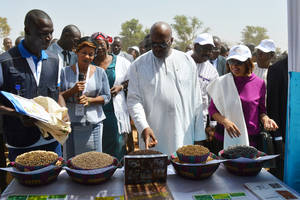This article originally appeared on fao.org.
Beans, lentils and chickpeas are small but powerful allies in achieving the Sustainable Development Goals

10 February 2017, Rome/Ouagadougou - The International Year of Pulses (IYP) has helped raise awareness globally of the many benefits of pulses, and boosted knowledge sharing and partnerships, but gains must be further strengthened to achieve the international community's Sustainable Development Goals. That was the message from the Year's official closing ceremony, hosted by Burkina Faso with the UN Food and Agriculture Organization (FAO).
"It is essential to maintain the momentum," said FAO's Deputy Director-General Maria-Helena Semedo at today's ceremony. "Training programmes on the value of pulses should be supported, particularly for schoolchildren, farmers and extension workers. Policies and programmes should focus more on pulse producers, particularly small-holder farmers and young people," she said.
Burkina Faso's President, Roch Marc Christian Kaboré, said: “To better cope with the triple problem of soil fertility management, reducing the adverse effects of climate change and the issue of food security, producing and consuming pulses is a great opportunity, especially for the most vulnerable people.”
Defined as edible dried seeds of plants in the legume family, pulses are packed with minerals such as iron, zinc and folate. From hummus and falafel to dahl and baked beans, pulses have been an important part of diets around the world for centuries.
Finger on the pulse
With the slogan ‘Nutritious Seeds for a Sustainable Future', the International Year of Pulses was launched in November 2015, and the UN General Assembly nominated FAO to lead implementation. Since then, connections have been fostered among key actors from farmers' organizations to the private sector to facilitate information exchange and policy dialogue on the production, trade and consumption of pulses.
Leaders in policy and research have tackled the top pulse issues at several international fora, and national committees have been established. A technical pulses database was created, a cookbook featuring recipes from international chefs was published, and the official multilingual IYP website, with over half a million visits, promoted a rich array of information on pulses.
During today's ceremony, the six IYP Special Ambassadors, represented by leading Egyptian TV chef Magy Habib, were thanked for their dedication and valuable services.
Power-packed pulses to help end hunger
Pulses are a valuable ingredient in achieving Sustainable Development Goal 2 which aims to end hunger, achieve food security and improved nutrition, and promote sustainable agriculture.
The plants contribute to climate change adaptation and mitigation. They add large amounts of beneficial nitrogen to the soil and require little fertilizer. Growing pulses with other crops enhances soil fertility, improves both crops' yields, and contributes to a more sustainable food system.
In addition, pulses have a very low water footprint compared to other protein sources, can be grown in very poor soils, and help reduce the risk of soil erosion and depletion. For poor farmers, growing pulses contributes to stable livelihoods, additional income and improved nutrition.
Production on the rise
Overall, global pulse production has been slowly but steadily increasing. In 2014, global production reached 77 million tonnes, up 21 million tonnes since 2001.
In Burkina Faso, where pulses are generally grown by rural women, production is also on the rise. The government estimates that 700 000 tonnes of cowpea and 56 000 tonnes of bambara (or voandzou) beans will be produced this year — around 20 percent more than last year.
Though the International Year of Pulses has now officially closed, there has been a sound call to keep the momentum alive and continue activities beyond 2016. FAO will carry on working with stakeholders from governments to family farmers to champion pulses as small but powerful allies in achieving the Sustainable Development Goals.
